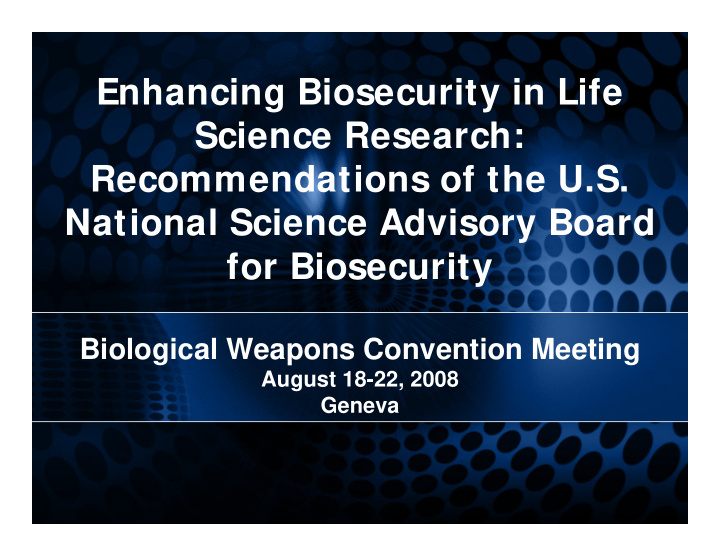



Enhancing Biosecurity in Life Science Research: Recommendations of the U.S. National Science Advisory Board for Biosecurity Biological Weapons Convention Meeting August 18-22, 2008 Geneva
The “Dual Use” Issue � Life sciences research underpins: – Biomedical and public health advances – Improvements in agriculture – Safety and quality of food supply – Environmental quality – Strong national security and economy � However, good science can be put to bad uses
National Academies Report on Dual Use Research Report of the National Research Council of the National Academies: “Biotechnology Research in an Age of Terrorism: Confronting the Dual Use Dilemma” (October 2003)
Life Sciences: Need for Biosecurity � “Dual use” potential of certain life sciences research requires consideration of biosecurity measures � Need to minimize the likelihood that biological research findings will be misused for production and enhancement of biological weapons � Goal: enhance biosecurity protections for life sciences research while ensuring that any impact to the free flow of scientific inquiry is minimized
US Government Response � Agreement that new biosecurity measures warranted � Series of biosecurity initiatives, including establishment of National Science Advisory Board for Biosecurity
National Science Advisory Board for Biosecurity (NSABB) � Recommends strategies to minimize risk that legitimate scientific findings will be misused � Advises the heads of all US federal departments and agencies with an interest in life science research
Expertise of NSABB • Members: – Wide range of the life sciences, including research, clinical, and agricultural. – Also includes expertise in law, bioethics, biodefense, publishing, and representatives from academia, industry, and the public. • Ex Officios: – Wide representation of the U. S. Government, including 15 departments and agencies
Questions for the NSABB � How do we recognize dual use research? � How should research be reviewed? By whom? When? � How do we raise awareness of dual use research and foster strategies to minimize its misuse? � Should dual use research of concern be communicated? If so, how can this be done responsibly? � How can we promote international engagement on these issues?
Modus Operandi • Working Groups: – Oversight Framework Development – Codes of Conduct – Communication – International Collaboration – Synthetic Genomics • Iterative Consultations: – Wide ranging consultations within the domestic and international life sciences, public policy community, scientific publishing, bioethics and biosafety communities and the general public
Work Products and Recommendations • Criteria for Identifying Dual Use Research of Concern • Tools for Responsible Communication of Research with Dual Use Potential • Considerations in Developing a Code of Conduct for Dual Use Research in the Life Sciences • Recommendations on Synthetic Genomics
Current Activities • NSABB recommendations have been submitted to the U. S. Government for consideration in policy development – Oversight framework – Recommendations on synthesis of Select Agents • Formation of a Working Group on Outreach and Education – Developing a strategic plan to recommend to the U.S. Government • International Roundtable (3 rd ), November 2008 – To sustain the dialogue and foster awareness raising internationally
http://www.biosecurityboard.gov http://www.biosecurityboard.gov
Recommend
More recommend